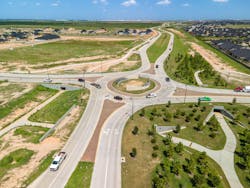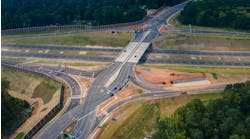The project team of the Texas Heritage Parkway considered a variety of needs of no less than 10 landowners, four construction contracts, six pipeline companies, two counties, two cities and one state agency to make their project a reality. They found the optimal solution in roundabouts.
The increasingly popular style of intersection is new to the Houston area, but the need for the 6.3 mile, four-lane parkway was first envisioned nearly 15 years ago as a critical north/south corridor connecting to two major east/west thoroughfares: the Farm to Market (FM) 1093 in Fulshear, and Interstate Highway 10 in Katy.
Construction of any 6.3-mile roadway can present its challenges. But the project team says one of its biggest was coordinating among the multitude of stakeholders. Because of this, every time a solution seemed to be within reach, another challenge presented itself.
The developers wanted the road to provide access for future development of their properties. Existing neighborhoods wanted to minimize the impact of the parkway while maximizing safety for pedestrians and cyclists. The county desired a continuous road that allowed for traffic to flow north and south through the burgeoning area.
To accommodate the needs of the stakeholders while keeping the project on schedule, the team implemented an accelerated construction timeline. The project was divided into four sections and ensured each section was completed on time to open for traffic. This meant construction of each section occurred simultaneously, which required active communication with the county engineer to approve plans and changes.
The project team also met with the contractors on a weekly basis to review progress, to stay on top of the schedule, and to ensure construction was following all safety protocols.
The resulting parkway, which features 10 roundabouts and no signalized intersections, was carefully integrated into the existing suburban lifestyle by the inclusion of a 10-foot-wide concrete walking and bicycling trail, as well as illuminated tunnels that take the trails underneath the roundabout intersections.
During construction of the tunnels, the team coordinated with homeowners who had expressed a strong desire for the roundabouts to be at ground level. So, homeowners wouldn’t look out of their window to an elevated roundabout, the tunnels were constructed based on a balanced solution to keep roundabouts as low as possible, while also being protected from flooding.
The team’s consideration also extended to potential environmental impacts.
The project team redesigned specific aspects of the parkway to save as many trees as possible to serve as a visual buffer between homes and areas. In one instance, to preserve a huge 250-year-old oak tree revered among residents, it was relocated by one of the developers 600 feet from the parkway’s path.
In addition, the project utilized decorative, fully shielded, dark-sky-compliant light fixtures at the roundabouts to minimize light pollution in surrounding neighborhoods. These light fixtures provide only enough light to keep drivers and pedestrians safe.
Gary Gehbauer, director of program management at BGE, Inc., said the project team is proud that they met the stakeholders’ needs. They also bridged a long-standing gap between communities and created a visually pleasing infrastructure solution.
“We’re elated to be recognized for this innovative roadway using 10 roundabouts, providing for the continuous flow of traffic, increasing safety, and minimizing maintenance, noise and light issues,” he said. “It’s rewarding to see how Texas Heritage Parkway has impacted the Fort Bend and Waller counties, and we are honored to be in the Top 10 Roads of 2023.”
Project Name: Texas Heritage Parkway
Project Location: City of Fulshear, Texas (Fort Bend County)
Owners: Texas Heritage Parkway Improvement District and Fort Bend County
Designer: BGE, Inc.
Contractors: Allgood Construction Co., Inc.
R Construction Company
Harris Construction Co.
Cost: $49.8 million
Length: 6.3 miles
Completion Date: August 2023



